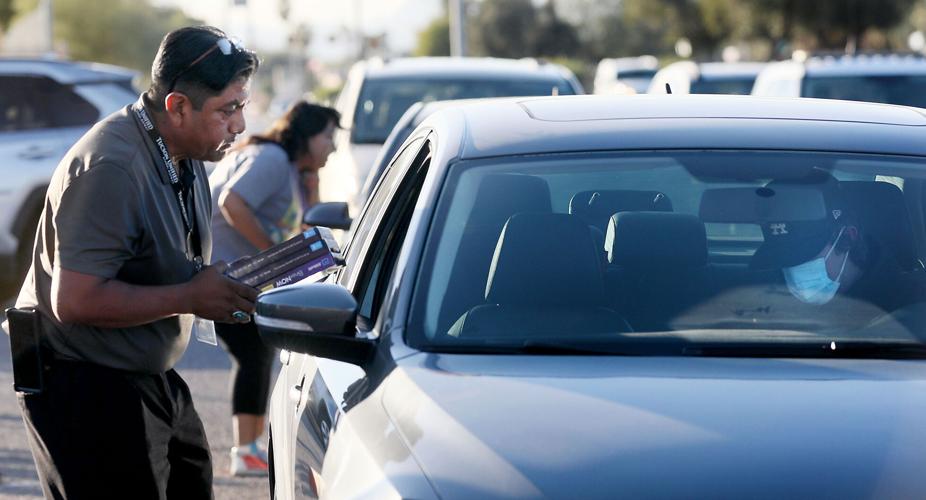Tucson’s largest school districts have stocked all campuses with supplies of naloxone — a medication also known by the brand name Narcan that can reverse effects of an opioid overdose — after health officials pointed to a community problem with fentanyl use.
In an October memo, the Pima County Health Department noted there are dramatically increasing levels of opioid misuse among K-12 populations. In particular, it noted, fentanyl has emerged as the leading cause of death in youths ages 6-19 in the county.
There have been a total of 63 overdose fatalities among ages 6-19 in Pima County since 2017, according to information from the Pima County Office of the Medical Examiner. Of those, 52 deaths involved fentanyl.
“Currently, the highest priority is to work with all local schools to help them establish overdose response protocols, which includes access to Narcan Nasal Spray on school grounds and training staff on how to respond during an overdose emergency,” wrote Theresa Cullen, the health department’s director, in a memo to the county administrator.
The county saw the highest number of overdose deaths between ages 6-19 in 2021, with a total of 22 deaths within that age group. That was higher than this year’s total of six deaths as of early November, and higher than 2020 when the county recorded 15 deaths.
Of the total 63 deaths in that age group within the past five years, 32 of those who died had residential addresses that fell within Tucson Unified School District, the county’s largest school district.
Seven who died had addresses within Sunnyside Unified School District, the second-largest in the county.
Those numbers only provide context about where those decedents lived, said the county’s forensic epidemiologist Natasha Tully. The data does not confirm whether they were enrolled in their corresponding districts or whether they were enrolled in school.
Also, she said, the locations of the overdose deaths may differ from the residential addresses.
No ODs known in TUSD, Sunnyside
TUSD is not aware of any overdose deaths among its students, said Joseph Gaw, the district’s director of health services.
He added that TUSD started stocking Narcan about five years ago and there have been no cases in which it was administered.
The same was said of the Sunnyside district, where Security Director Ryan Powell said there have been no overdose incidents. But, he expects it might happen in the future considering the rising use of fentanyl in the larger community.
Powell said Sunnyside started its Narcan program in 2020, shortly before schooling went remote due to the pandemic. There can be five to a dozen staff members trained to administer naloxone at each campus, depending on size of the school, he said.
“I know a lot of people carrying Narcan on campuses, who have not been specifically trained by us, but they do have that experience and got trained in other places,” he said, adding that a person doesn’t need to be certified to administer naloxone.
At TUSD, Gaw said the district initially stocked all high schools with Narcan about five years ago.
This year, responding to suggestions from the county health department, the district ensured for the first time that all campuses across the district have the medication on hand.
Both districts follow similar overdose response protocols. They begin with recognizing the signs of a potential overdose, which include difficulty breathing and unresponsiveness. If the symptoms are in line with an overdose, staff members call 911, then administer naloxone as prescribed.
District employees continue to monitor the individual’s health while waiting for first responders to arrive, and can also give a second dose of Narcan if the person’s breathing hasn’t improved, Gaw said.
In the meantime, school administrators contact parents and guardians. Powell added that the school then begins an investigation in order to take necessary measures to prevent another overdose.
Education and prevention
Powell said Sunnyside follows up on all drug offenses that arise across the district. Aside from possible suspension, he said, students also have to complete a drug education class and schools ask that parents get involved in the process to help combat the issue outside of campus.
Educating students and community is one of the most important factors in trying to prevent overdoses in TUSD as well, Gaw said.
“What worries us is that some of these pill forms of fentanyl look like candy, and so we have taken measures to be that one extra safety net for the children of the district,” Gaw said. “Sometimes, the school health office is their primary care portal.”
He said that they’ve been working closely with the county to bring the health department’s education measures to the district. Some of that has included obtaining Narcan Nasal Sprays from the county; setting up posters about how to respond in case of an overdose; and educating the community about fentanyl.
In the days leading up to Thanksgiving break, TUSD personnel held giveaway events in which they gave families free COVID-19 testing kits, while Pima County Health Department personnel provided information on overdoses and handed out Narcan kits.
“The health services team is responsible for the health and welfare of the school environment,” Gaw said. “What we do also impacts all of Tucson together because ... we’re a big school district. We touch every area of Tucson.”
The overdose-reversing drug naloxone has been linked to a decrease in opioid deaths.






